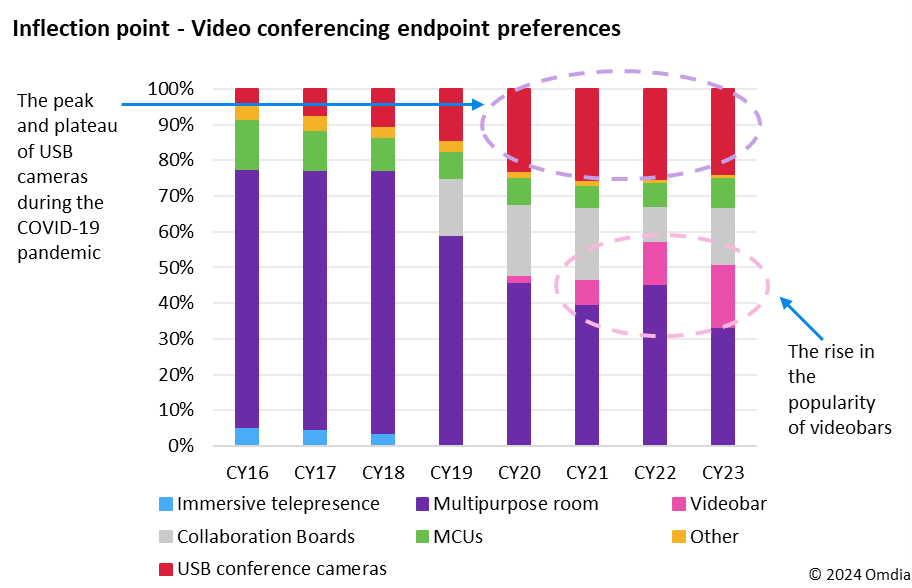Post-COVID-19, many businesses have reduced their real estate footprint, while others who have kept their offices struggle to fill them. Yet, the value of the office in the post-COVID-19 pandemic era remains significant in fostering a sense of belonging, culture, and creativity.
Fostering a superior employee experience is about understanding the employee journey within an organization right from joining an organization and continuing as they grow into a productive team member and extending until they depart from the company. While employees can onboard and work remotely using cloud-based collaboration solutions and home office solutions such as laptops, webcams, speakers, and microphones, the physical office can provide a more personal, intuitive, and satisfying user experience when required, such as in the initial onboarding process, training, in-person events or when teams want to collaborate in a physical space with those working remotely. Blending physical and virtual so that everyone is heard, treated equally, and has an equal opportunity to contribute and grow equates to a superior experience.
A well-integrated collaboration software and hardware system can collectively support and enhance an employee’s journey within the organization and drive employee experience via:
- Improving meeting equity for remote attendees
- Offering a consistent look and feel across all rooms and spaces
- Offering clear audio for increased productivity
- Allowing employees to use the meeting platform of their choice via Bring Your Own Meetings (BYOMs) setups
- Creating modular meeting rooms that can be adapted based on employee needs
- Offering enhanced voice and face recognition in meeting rooms for better meeting transcription, meeting summaries, and remote attendees’ engagement.
- Deploying artificial intelligence (AI)-infused collaboration boards that allow in-room and remote attendees to do real-time digital whiteboarding.
- Using sensor-based technologies for controlling and gathering room telemetry for a better experience
Yet, many meeting rooms globally do not have video collaboration capability. According to Omdia’s research, 80% of meeting rooms globally remain video unequipped. In our recent Video Conferencing Equipment and Service Survey, we asked enterprises why they would upgrade meeting rooms in the next two years. Figure 1 highlights the top five responses:
These survey data correspond with the key messages from the collaboration hardware vendors exhibiting at Enterprise Connect 2024—today’s offices need hardware solutions that work seamlessly with the collaboration software to offer deeper collaboration opportunities and drive superior employee experience. This is true despite the many AI-led features—such as transcription, translation, smart summaries, meeting notes, etc.—emerging in the cloud-based collaboration services for enhanced collaboration and employee experience.
Omdia’s Video Conferencing Equipment and Peripherals Market Tracker highlights that some device categories have fallen out of favor as new categories have emerged to support enterprises transitioning to hybrid work.
Vendors are very keen to address their customers’ pain points, and I saw three distinct approaches emerging to address the hybrid work conundrum:
- Flexible and modular solutions and deployments that can be customized to meet unique requirements in open areas, rooms with glass walls, odd-shaped rooms, and multi-purpose spaces
- Solutions that offer consistent employee experience, whether from a desk, a meeting room, a home office, or open collaboration spaces to facilitate non-assigned seating/hotdesking setups
- Intelligent AI-based solutions to deliver cinematic experiences that do not require a production studio or dedicated video production team
Flexible collaboration hardware
Why is it important? Some enterprises do not want to dedicate meeting rooms for specific purposes only if a lack of floor space or available meeting rooms constrains them. Enterprises also want to optimize the available space without hindering collaboration. Here are the vendors leading in this category:
- Neat, a front-runner offering flexible collaboration hardware, stands out with its innovative modular and flexible solutions—including the Neat Board, Neat Bar, and Neat Center—which enable IT and facilities to construct and personalize meeting rooms to their specific business needs and facilitate easy adaptation and reuse for future requirements. Neat further empowers its customers to enhance customization with the Neat App hub, which provides access to third-party business applications such as Miro, Appspace, etc., on Neat devices. Neat Boards, for example, running Microsoft Teams on one and Miro on the other, can pair up to work in sync, offering further flexibility. Another compelling offering from Neat is its upgraded Neat Pulse, a cloud-based monitoring and managing platform that enables customers to manage their devices remotely.
- Barco is another vendor that is standardizing on offering flexible solutions for meeting rooms. Its latest offering, called the Clickshare Bar and Bar Pro, is a carbon-neutral, all-in-one bar that can be deployed in small- and medium-sized meeting rooms with any video conferencing platform. This solution significantly simplifies installation, allows users to bring their own meetings, and reduces the Total Cost of Ownership, thus allowing enterprises to scale video across more meeting rooms. Barco’s Clickshare Bar removes the need to purchase room licenses from Microsoft, Zoom, and others as it is designed to bring your own device spaces.
- Jabra, a rapidly emerging vendor in the video conferencing space, also aims to be the leader in offering flexible collaboration solutions. Jabra’s solutions provide high-quality audio and a range of video solutions for meeting rooms of different sizes.
Consistent employee experience
Why is it important? Consistent employee experience helps to nurture a motivated, committed, and high-performing workforce. It is especially critical for organizations that have embraced hybrid work to offer a consistent experience regardless of whether an employee is working from the office or home. Collaboration solutions with the same look and feel across all workspaces have been shown to boost engagement and productivity, retain talent, and foster a strong workplace culture. They contribute to employees’ overall well-being and enhance the company’s reputation. Here are the vendors leading in this category:
- Cisco remains the undisputed front-runner in offering a broad range of collaboration hardware for all collaboration spaces and user personas, allowing employees to adopt solutions rapidly and have a consistent experience regardless of location. The vendor has rapidly expanded its portfolio of collaboration devices that can be quickly deployed from individual workspaces to meeting rooms of all sizes and configurations. This approach gives Cisco an edge, allowing IT and facilities teams to standardize deployments and scale faster. Cisco’s solutions are now Microsoft Teams-certified, an added advantage to organizations that have standardized Microsoft Teams.
- Yealink is another vendor with a robust end-to-end portfolio of audio and video conferencing and collaboration and open collaboration spaces to provide remote attendees with a more engaging meeting experience and equity. Its solutions are affordable, quick to deploy, and are Microsoft Teams- and Zoom-certified
- HP|Poly remains uniquely positioned to offer a consistent collaboration experience through its end-to-end collaboration solutions, including enterprise-grade headsets, laptops, IP phones, meeting room solutions, and Windows computing for Microsoft Teams and Zoom rooms. The vendor announced its upcoming center-of-the-room e360. This camera offers dynamic features, including B-based auto exposure, for accurately representing diverse lighting and skin tones.
Intelligent AI-based solutions to deliver immersive experiences
To earn employees’ commutes, enterprises must offer experiences they don’t have at home, foster inclusivity and meeting equity, support young workers and new employees, and build a culture that promotes trust, collaboration, and respect. Attracting employees to offices requires making the office a magnet, not a mandate, and to support their customers, vendors are incorporating AI in their solutions to offer enhanced meetings that seamlessly blend virtual and physical spaces.
- Huddly leads this category, offering intelligent AI-based meeting room solutions to bring an immersive experience in all room types and settings. Its offering, called the Huddly Crew, combines three 6K network cameras to capture participants from multiple angles, their body language, and their involvement in meetings.
Huddly Director, an AI-powered technology that edits the meeting in real time, controls the cameras, switching between various shots and angles for a dynamic and engaging experience. Huddly also works very closely with partners such as Barco, Shure, Crestron, and Solstice to offer solutions that can be deployed across various collaborative meeting services from Microsoft Teams rooms to Zoom and others.
- Cisco is also driving meeting room experiences with its AI-infused innovations. The vendor offers optimized framing and AI-driven camera intelligence for Cisco devices, ensuring everyone has an equal seat at the table. With cinematic meetings enabled on Cisco RoomOS, facial expressions, body language, and valuable in-room context all come to the fore, creating an authentic, seamless collaboration experience for remote and in-office participants.
What’s next in the video collaboration space
Technology alone cannot drive the creation of office spaces that deliver immersive experiences; it requires deep thinking that links employee needs, the organization’s culture, user personas, work processes, and customer requirements to make an impact. These challenges need urgent attention as enterprises plan for the office’s role in their organization.
Vendors who listen to their customers and design solutions that appeal to a broad set of use cases will emerge as winners.
For further details on this analysis, go to Omdia's website and read this report.












